Baklava
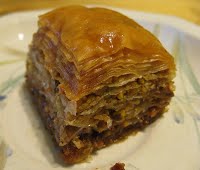
Author: Francis Esmonde-White
Published: 2011-04-01
Overview
This is based on a baklava recipe we found online at allrecipes.com. Our version is a bit more specific in terms of what nuts to use, and details on the actual fabrication process. I have always loved baklava, but I particularly owe my appreciation of baklava to Moustafa Kebbewar, who introduced me to really good baklava when we were studying together. I like to eat it in kilogram quantities (I'm kidding, mostly), so it's much more affordable when I make baklava myself. I have also become a bit of a baklava snob, and really enjoy baklava prepared with the nut mixture spread evenly through the phyllo layers. Most commercially prepared baklava has all the nut mixture in a single layer near the bottom. I much prefer when the nut mixture is spread more or less evenly throughout the layers.
Prep time: 30 min
Cook time: 50 min
Total time: 1 hr 20 min
Yield: 1 9"x14" pan (40-50 servings) - the pan size isn't critical, but it should either be the same size or smaller than the phyllo dough sheets
Serving size: 1.5"x1" pieces
Ingredients
For the baklava:
- Cashews: 8 oz. (1/2 pound, note that nuts tend to be very expensive at most grocery stores. We purchase nuts at Trader Joe's or other local small grocers.)
- Pistachios: 8 oz. (1/2 pound)
- Butter: 1 cup (let soften at room temperature until soft)
- Cinnamon powder: 1 teaspoon
- Phyllo dough (1 package , 16 oz.. Note that frozen phyllo dough sheets are not available in all grocery stores, we purchase ours at Kroger under the Athens fillo dough brand)
For the syrup:
- Water: 1 cup
- White sugar (granulated): 1 cup
- Honey: 1 cup (we get the 3 pound containers of 100% desert mesquite honey at Trader Joe's)
- Vanilla extract: 1 teaspoon (Again, don't skimp! Use the real stuff.)
Directions
Let the butter soften on the counter, and let the frozen phyllo dough thaw out. Completely thaw out (around 2 hours, follow the instructions on the box). If you try to make baklava before the phyllo dough has thawed, the dough will crack/break/tear into lots of pieces, and you will be unhappy. Don't rush the phyllo dough: it may be thawed out on the outside, but still frozen inside.
Next, make the nutmeat mixture. Chop/grind the cashews and pistachios together. We use a food processor, but make sure not to turn the nuts into a powder, you want to have small pieces (1/8 -1/16" diameter) present. If the nuts are powdered, the baklava won't have quite the right final texture. Mix the cinnamon into the nuts.
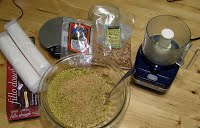
Butter a 9"x14" pan (see note on Yield above). I melt all the butter and use a small silicone basting brush to apply the butter (you're going to spend a lot of time applying melted butter). Unroll the thawed phyllo dough onto a flat surface. If necessary, cut the stack of phyllo dough so that it is the same size as the pan. Cover the phyllo dough with a damp cloth. The dough should not dry out while you're working, but it shouldn't be wet either. If you work quickly enough, it should not dry out. Karen and I always work together on baklava to make sure we go quickly enough (about 1 minute per layer).
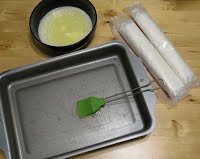
Place 2 sheets of phyllo dough in the buttered pan. Apply more melted butter to the top of the phyllo sheets in the pan. Repeat until there are 6-8 sheets at the bottom of the pan (this is the foundation for the baklava). When we do this, one of us lifts and places the phyllo dough, then holds it down (with dry fingers). The other applies the butter with the brush (and ends up with butter-fingers- which makes it impossible to touch the phyllo without ripping it).
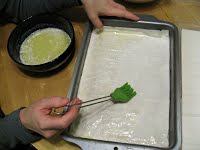
Spoon a thin layer (very thin! about 1-2 mm) of the nutmeal mixture evenly across the top of the buttered phyllo. Layer 2 more sheets of phyllo dough above the nutmeat (as in step 4, except we both spoon the nutmeat over the phyllo dough). Repeat this until there are about 6 sheets of phyllo dough left. Commercial places typically put all the nutmeat into just a few layers (1-3 seems to be common), resist the temptation to get lazy and you will be pleased.
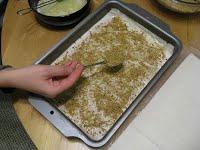
Repeat step 4 with the last few remaining phyllo sheets (about 6 sheets). I'm a glutton for punishment and typically liberally brush the remaining butter over the top of the baklava in the pan. This helps solidify the top of the baklava for the next step.
Heat up the oven (350 F).
Cut the baklava in the pan (before baking it!). I typically cut it into 1"x1" or 1"x2" squares, though triangles also look nice. Make sure you cut all the way through to the bottom. The baklava will compress wherever cut, and there will be deep grooves that remain after cooking. These grooves allow the baklava to suck up the syrup.
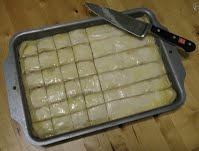
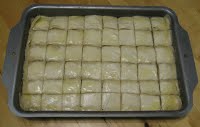
Bake the baklava for about 50 minutes. It should be flaky and golden on the top. I like it a dark golden color.

While baking the baklava, make the syrup about 25 minutes before the baklava is finished baking. Bring the water to a boil and dissolve the sugar. Add the honey and bring the sauce down to a simmer. Add the vanilla right before pulling the baklava out of the oven.
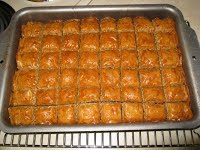
With the baklava still really hot, spoon the sauce over the baklava. It makes a fantastic crackling and sizzling sound as the sauce is added, definitely one of our favorite parts of the whole endeavor. Don't skimp: pour the entire mixture over the baklava.
Video: Spooning the syrup over the baklava
Let the baklava cool completely, it will solidify. It seems to keep forever... or at least as long as I can hold back from eating it all.
